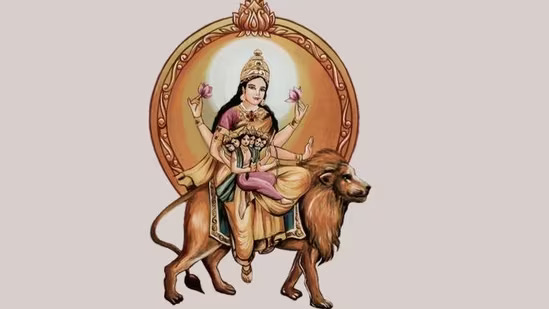Navratri is a nine-day Hindu festival that celebrates the nine forms of Goddess Durga. Each day of Navratri is dedicated to a different form of the goddess, and devotees worship her with great devotion and enthusiasm. The fifth day of Navratri is dedicated to Goddess Skandamata, the fifth manifestation of Maa Durga.
Skandamata is the mother of Lord Kartikeya, the commander-in-chief of the gods. She is depicted as seated on a lotus, holding her infant son in her lap. Skandamata is a symbol of motherhood, compassion, and love. She is also known as the giver of all good things.
Significance of worshipping Maa Skandamata on Day 5 of Navratri
Worshipping Maa Skandamata on Day 5 of Navratri is believed to bring many benefits. She is known to bless her devotees with children, good health, and happiness. She also helps to remove obstacles and achieve success in one’s endeavors.
Childless couples often worship Maa Skandamata seeking her blessings for a child. She is also worshipped by students and professionals for success in their studies and careers.
Puja vidhi, timing, and samagri for Day 5 of Shardiya Navratri
Puja vidhi
To worship Maa Skandamata on Day 5 of Navratri, devotees can follow the following steps:
- Clean and decorate the puja area.
- Place an idol or image of Maa Skandamata in the center of the puja area.
- Light a lamp and offer incense sticks.
- Offer flowers, fruits, and sweets to the goddess.
- Chant the following mantra:
Om Devi Skandamatayai Namah
(Repeat 108 times)
- Recite the Durga Saptashati or other hymns dedicated to Maa Skandamata.
- Pray to the goddess for your blessings.
Puja timing
The auspicious time to worship Maa Skandamata on Day 5 of Navratri is during the Brahma Muhurta, which is the early morning hours before sunrise. However, devotees can worship the goddess at any time of the day.

Puja samagri
The following items are required for the puja:
- Idol or image of Maa Skandamata
- Flowers (yellow flowers are considered to be auspicious for Maa Skandamata)
- Fruits (bananas, coconuts, and apples are considered to be auspicious for Maa Skandamata)
- Sweets (halwa, kheer, and ladoos are considered to be auspicious for Maa Skandamata)
- Incense sticks
- Lamp
- Ganga jal
- Kumkum
- Akshat
Other rituals and traditions
On Day 5 of Navratri, devotees also observe a fast. Some devotees also perform a special puja known as the “Panchopchar Puja,” which involves offering five elements to the goddess: food, water, flowers, incense, and a lamp.
Conclusion
Worshipping Maa Skandamata on Day 5 of Navratri is a way to invoke her blessings and grace in our lives. She is a symbol of motherhood, compassion, and love. She is also the giver of all good things. By worshipping her with devotion, we can seek her blessings for children, good health, happiness, success, and prosperity.
Additional information
Other names of Maa Skandamata
- Padmasana Devi
- Shambhavi
- Tarini
Mantra for Maa Skandamata
Om Devi Skandamatayai Namah
Benefits of worshipping Maa Skandamata
- Blessings for children
- Good health
- Happiness
- Success in one’s endeavors
- Removal of obstacles
- Attainment of prosperity
Tips for worshipping Maa Skandamata
- Worship with a pure heart and devotion.
- Offer flowers, fruits, and sweets that are considered to be auspicious for the goddess.
- Chant the mantra for Maa Skandamata with faith.
- Recite the Durga Saptashati or other hymns dedicated to the goddess.
- Pray to the goddess for your blessings.
Celebrating Motherhood with Maa Skanda Mata
Maa Skanda Mata is the epitome of motherhood. She is the loving and caring mother of Lord Kartikeya. She is also known as the giver of all good things. On Navratri Day 5, we celebrate the power of motherhood with Maa Skanda Mata.
Why is Motherhood So Important?
Motherhood is the foundation of society. Mothers play a vital role in the upbringing of their children. They teach their children about right and wrong, about love and compassion, and about the importance of hard work and perseverance. Mothers also provide their children with a sense of security and belonging.





